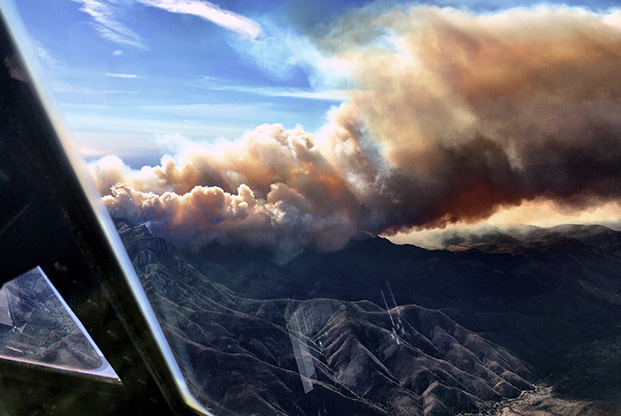
Aircrew and support from the 146th Airlift Wing at Channel Islands ANGS, California accomplished four fire-retardant drops between November 13-14, 2018, over the Woolsey Fire just a few miles east of their home base. Air National Guard photo by SSgt. Nicole Wright.
Thirty-two of the Air Force’s 35 “mission assurance priority installations” located across 22 states are vulnerable to wildfires, according to a Pentagon report on the implications of climate change that was released Jan. 18.
The report, which was mandated by the 2018 National Defense Authorization Act, evaluated “significant vulnerabilities from climate-related events in order to identify high risks to mission effectiveness on installations and to operations.” It broke these threats down into five categories: wildfires, recurrent flooding, drought, desertification, and thawing permafrost—the last of which, it said, wasn’t applicable to any USAF installations observed as part of the report. It also outlined Defense Department efforts to make US military installations more resilient and its operations more viable in the face of climate-related challenges.
WILDFIRES
The installations with the highest risk of wildfire damage in the next 20 years, broken down by state, are:
-
Alaska: Clear AFS and JB Elmendorf-Richardson
-
California: Beale AFB, Vandenberg AFB
-
Colorado: Buckley AFB, Cheyenne Mountain AFS, Greeley ANGS, Peterson AFB, Schriever AFB
-
Florida: Cape Canaveral AFS, Eglin AFB, MacDill AFB, Patrick AFB
-
Georgia: Warner Robins AFB
-
Illinois: Scott AFB
-
Louisiana: Barksdale AFB
-
Kansas: McConnell AFB
-
Massachusetts: Cape Cod AFS
-
Maryland: JB Andrews
-
Michigan: Selfridge ANGB
-
Missouri: Whiteman AFB
-
Montana: Malmstrom AFB
-
New Mexico: Kirtland AFB
-
Nevada: Creech AFB, Nellis AFB*
-
Ohio: Wright-Patterson AFB
-
Oklahoma: Tinker AFB
-
South Carolina: Shaw AFB
-
Texas: JB San Antonio
-
Utah: Hill AFB*
-
Virginia: JB Langley-Eustis
-
Wyoming: F.E. Warren AFB
*In the report, USAF noted that the risk assessments for Nellis AFB, Nev., and Hill AFB, Utah, refer “only to installation sites within the main base” and that “when associated ranges are included,” they are deemed to be at current and future wildfire risk.
The only installations deemed immune from current or future wildfire risk were Cavalier AFS, N.D., Minot AFB, N.D., and Offutt AFB, Neb. It was determined the Gunter Annex at Maxwell AFB, Ala., also was safe from this threat, though the base as a whole was not evaluated for the report.
While the Camp and Woolsey Fires, which burned close to Beale AFB, Calif., and Channel Islands AGS, Calif., respectively, last year are the most recent example of this threat, the report explained that “wildfires are a constant concern” because of “routine training and testing activities that are significant ignition sources.” The report also said high winds and drought can make wildfire activity more severe, and lead to “infrastructure and testing/training impacts.”
One such perfect storm highlighted in the report was a pair of linked March 2018 wildfires in Colorado caused by live-fire training held “during an infantry and helicopter training exercise for an upcoming deployment.” The blazes, which the report said were spread by “gusty winds and dry conditions,” stretched across approximately 3,300 acres, and forced the evacuation of 250 homes. It destroyed three of them.
The report also highlighted the September 2016 Canyon Wildfire at Vandenberg AFB, Calif., that set more than 10,000 acres ablaze. That fire closely approached “two Space Launch Complexes,” delayed a rocket launch, and took out some electrical power lines on the base.
The report said that, from a research perspective, DOD is partially combating wildfire risk through the Fire Science Strategy that its Strategic Environmental Research and Develop Program developed in 2014. The strategy centers around “improved characterization, monitoring, modeling, and mapping of fuels to support enhanced smoke management and fire planning at DOD installations; enhanced smoke management using advanced monitoring and modeling approaches; and research to quantify, model, and monitor post-fire effects.”
RECURRENT FLOODING
The report found that 20 of the analyzed USAF installations are currently vulnerable to recurrent flooding, and a total of 25 could be at risk within the next 20 years.
The individual services and the Defense Logistics Agency tackle the resiliency challenge by integrating “weather and climate considerations into existing plans and processes” and by joining forces with federal agencies, state and local governments, “non-governmental organizations, and local communities” to boost “preparedness and resilience,” the report said.
From a USAF perspective, the report highlighted installation-specific efforts to increase resiliency, such as JB Langley-Eustis’ use of flood modeling and sea-level-minded construction regulation, and civilian-military partnerships at Eglin and MacDill to combat coastal erosion.
DROUGHT AND DESERTIFICATION
Drought was found to affect 20 installations right now, with a total of 22 potentially at risk in the future. The potential impacts of droughts on USAF installations are numerous, according to the report. They include: potential impacts to water supply in places that rely on surface water, worsening wildfire risk and severity due to dried-out vegetation, inducing “heat-related illnesses” in service members, and impairing “testing activities.” The increased temperature that comes with drought also could increase “the number of black flag day prohibitions for testing and training,” while raising energy consumption when more facility cooling is needed.
In addition, four of the USAF installations studied—Kirtland AFB, N.M., Creech, Nellis, and Hill—are considered vulnerable to desertification. According to the report, this process “results in reductions in vegetation cover leading to increases in the amount of runoff from precipitation events” that can, in turn, increase erosion rates and can pose “challenges related to training and maneuvers.”